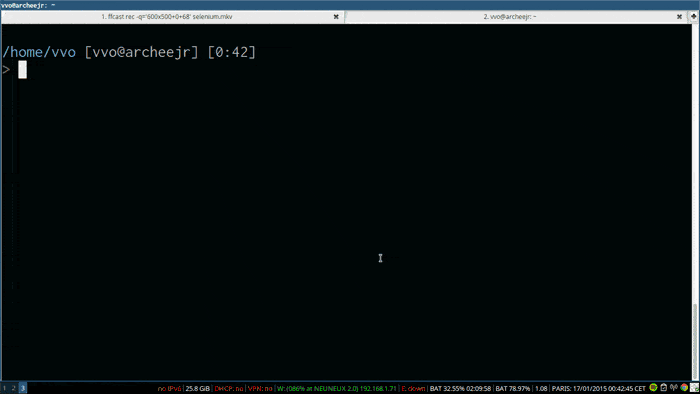Command line or programmatic install and launch of selenium standalone server, chrome driver, internet explorer driver, firefox driver and phantomjs
It will install a selenium-standalone command line that will be able to install selenium server and start firefox, chrome, internet explorer or phantomjs for your tests.
npm install selenium-standalone@latest -g
selenium-standalone install
selenium-standalone start# simple, use defaults and latest selenium
selenium-standalone install
selenium-standalone start
# install defaults, but silently
selenium-standalone install --silent
# specify selenium args, everything after -- is for selenium
selenium-standalone start -- -debug
# choose selenium version
selenium-standalone install --version=2.45.0 --baseURL=https://selenium-release.storage.googleapis.com
# choose chrome driver version
selenium-standalone install --drivers.chrome.version=2.15 --drivers.chrome.baseURL=https://chromedriver.storage.googleapis.com
# choose ie driver architecture
selenium-standalone start --drivers.ie.arch=ia32 --drivers.ie.baseURL=https://selenium-release.storage.googleapis.com
# specify hub and nodes to setup your own selenium grid
selenium-standalone start -- -role hub
selenium-standalone start -- -role node -hub http://localhost:4444/grid/register
selenium-standalone start -- -role node -hub http://localhost:4444/grid/register -port 5556
var selenium = require('selenium-standalone');
selenium.install({
// check for more recent versions of selenium here:
// https://selenium-release.storage.googleapis.com/index.html
version: '2.45.0',
baseURL: 'https://selenium-release.storage.googleapis.com',
drivers: {
chrome: {
// check for more recent versions of chrome driver here:
// https://chromedriver.storage.googleapis.com/index.html
version: '2.15',
arch: process.arch,
baseURL: 'https://chromedriver.storage.googleapis.com'
},
ie: {
// check for more recent versions of internet explorer driver here:
// https://selenium-release.storage.googleapis.com/index.html
version: '2.45.0',
arch: process.arch,
baseURL: 'https://selenium-release.storage.googleapis.com'
}
},
logger: function(message) {
},
progressCb: function(totalLength, progressLength, chunkLength) {
}
}, cb);opts.version selenium version to install.
opts.drivers map of drivers to download and install along with selenium standalone server.
Here are the current defaults:
{
chrome: {
version: '2.15',
arch: process.arch,
baseURL: 'https://chromedriver.storage.googleapis.com'
},
ie: {
version: '2.45.0',
arch: process.arch,
baseURL: 'https://selenium-release.storage.googleapis.com'
}
}arch is either ia32 or x64, it's here because you might want to switch to a particular
arch sometimes.
baseURL is used to find the server having the selenium or drivers files.
opts.basePath sets the base directory used to store the selenium standalone .jar and drivers. Defaults to current working directory + .selenium/
opts.progressCb(totalLength, progressLength, chunkLength) will be called if provided with raw bytes length numbers about the current download process. It is used by the command line to show a progress bar.
opts.logger will be called if provided with some debugging information about the installation process.
cb(err) called when install finished or errored.
opts.drivers map of drivers to run along with selenium standalone server, same
as selenium.install.
opts.basePath sets the base directory used to load the selenium standalone .jar and drivers, same as selenium.install.
By default all drivers are loaded, you only control and change the versions or archs.
opts.spawnOptions spawn options for the selenium server. Defaults to undefined
opts.seleniumArgs array of arguments for the selenium server, passed directly to child_process.spawn. Defaults to [].
opts.spawnCb will be called if provided as soon as the selenium child process was spawned. It may be interesting if you want to do some more debug.
opts.javaPath set the javaPath manually, otherwise we use [which](https://github.com/isaacs/node-which).sync('java')
cb(err, child) called when the server is running and listening, child is the ChildProcess instance created.
So you can child.kill() when you are done.
If you're getting this error, it means that you didn't shut down the server successfully the last time you started it, so it's still running in the background. You can kill it by running:
pkill -f selenium-standaloneBy default, google chrome, firefox and phantomjs are available when installed on the host system.
After installing selenium-standalone globally, execute the following commands to run selenium-standalone when your machine starts!
ln -s /usr/local/bin/selenium-standalone /etc/init.d/
update-rc.d selenium-standalone defaultsFor more information: https://stackoverflow.com/questions/3666794/selenium-server-on-startup/30392437#30392437
On linux,
To run headlessly, you can use xvfb:
xvfb-run --server-args="-screen 0, 1366x768x24" selenium-standalone startBy default, Selenium sends logging messages to stderr.
The selenium-standalone cli tool (selenium-standalone start) will output the logging messages to your process.stderr. So you do see them in the console.
If you are using the programmatic API, you can retrieve the stderr messages by doing this:
var selenium = require('selenium-standalone');
selenium.start(function(err, child) {
child.stderr.on('data', function(data){
console.log(data.toString());
});
});You can also forward the stderr to your process.stderr like the cli does:
var selenium = require('selenium-standalone');
selenium.start({
spawnOptions: {
stdio: 'inherit'
}
}, function(err, child) {
// child.stderr now sent to your `process.stderr`
});


